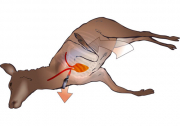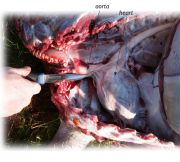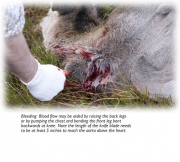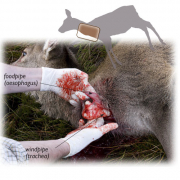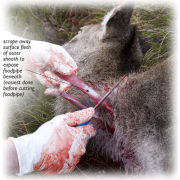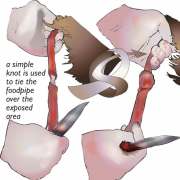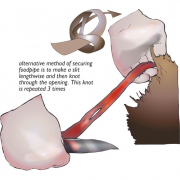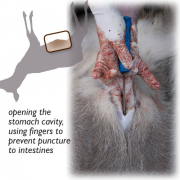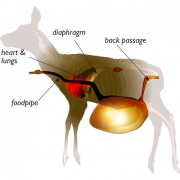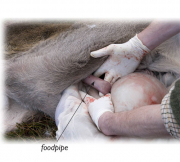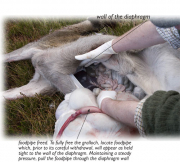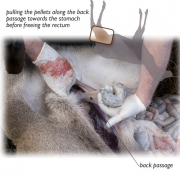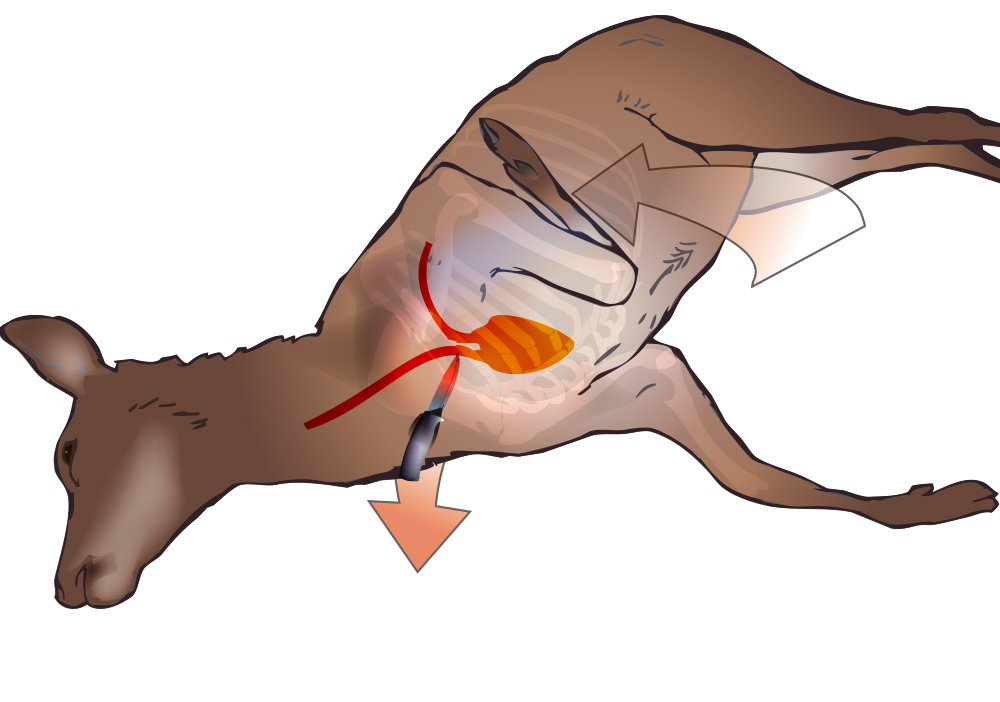
Bleeding: Note that the length of the knife blade needs to be at least 5 inches in larger deer to reach the aorta.
Aim
The aim of this guide is to provide practical guidance on the initial stages of preparing a carcass immediately after the deer has been shot and death confirmed.* The BP Guide Carcass Inspection should be viewed as an essential accompaniment to this guide.
Introduction
The purpose of gralloching is to:
- Reduce contamination of the meat by gut contents;
• If the guts are damaged by the shot, prompt gralloching can significantly reduce the degree of contamination.
• If the guts are intact, it is accepted wisdom that bacteria will migrate through the gut wall in time − the slower the cooling of the carcass and warmer the day, the faster this process. - Help cool the carcass;
- Reduce tainting of the meat from blood by:
• Cutting the aorta at the heart to bleed out the main blood vessels; - Releasing blood in the chest resulting from the shot.
Great care must be taken during the initial carcass processing as this is when the majority of food contamination can take place.
Procedure
1. Reduce contamination risk
- Ensure hands are clean. Ensure any open wounds or sores on hands are covered e.g. by using disposable gloves.
- Use a knife that can be easily cleaned (e.g. a one-piece knife carried in a scabbard or a folding knife).
- Minimise the extent of knife work to the carcass to reduce the risk of contamination, especially if dragging.
- Avoid removing head and feet in the field to minimise contamination of exposed meat.
- Cleanse the knife before and between gralloching animals (e.g. with a sterile wipe). Do not stick the knife into the ground at any point.
- If gut contents have spilled into the stomach cavity, attempt to remove as quickly and a thoroughly as possible (where practical, this is best achieved by wiping out the worst of the solid content with disposable paper towels or as a last resort by using clean sphagnum moss).
2. Bleed
- Turn deer on its side with the head downhill if possible. Position front leg of deer to give tension to the skin surrounding the breastbone.
- Insert blade immediately above breast bone and point toward the heart, so that it penetrates the chest cavity. Work the blade around until the blood flows freely (see illustrations above).
- To ensure blood has drained, bend lower foreleg back and press hard on rib cage to force remaining blood in the chest out the hole.
- If the carcass is to be extracted by dragging, it is advisable to ensure that any cuts to the carcass are kept to a minimum. In such a case, the chest cavity may be bled through the diaphragm when opening the stomach cavity.
- If intending to attach a drag rope to the jaw at a later time, wedge the jaw slightly open before rigor mortis sets in.
3. Tie the foodpipe
To prevent carcass contamination from stomach contents you should tie off the foodpipe.
- From the bleeding incision make a cut up the centre of the neck exposing the windpipe (trachea) behind which is the foodpipe (oesophagus). If the carcass is to be dragged keep this incision as small as possible. Separate the foodpipe from the windpipe and cut it as high up the neck as to allow a length to tie. There are a number of ways of doing this:
• Pinch the foodpipe and seal using a clean cable-tie;
• Scrape off flesh downwards from a short length and knot;
• Make a small slit in the foodpipe (approx 1cm or small enough just to insert a finger) and loop the cut end through the slit. Repeat the loop three times to secure.
This process prevents leakage of stomach contents into the chest cavity when removing food pipe and stomach. - Push thumb and fore-finger down along the outside of the foodpipe, through the chest hole made when bleeding and pull with enough pressure to free connective tissue without breaking the foodpipe. This makes it easier to remove later. In cases where cuts to the carcass need to be minimised (e.g. where the carcass is to be dragged), an alternative to opening the neck is to access the foodpipe through the diaphragm after opening the stomach cavity. Ensure that stomach contents are pulled back towards the stomach and that the tube is secured to prevent spillage when drawing it into the stomach cavity.
4. Open up the stomach cavity
- Turn the deer on its back, and, taking care not to puncture the intestines or stomach, make an incision with the blade of knife, that runs from just forward of the udder or to either side of the penis to the breast bone. Try to avoid cutting into the udder or the urethra behind the penis as this can contaminate meat.
5. Remove the stomach and intestines
- Turn the deer on it’s right side and use fingers to break the connective tissue between the spleen and the diaphragm. Break off the blood vein attached to the liver. Leave the spleen attached to the stomach and remove the stomach and intestines leaving behind the liver, kidneys, lungs and heart. You can also squeeze the bladder at this point to empty it; however, care must be taken if this is to be carried out on male deer. You should also remove the foetus at this stage taking care not to puncture the surrounding protective sac.
6. Free the foodpipe
- The gralloch will still be attached to the carcass by the foodpipe. Use fingers to break connective tissue to free the knotted foodpipe where it passes through the diaphragm. Grip the foodpipe and, applying a steady pull to it, draw it carefully into the stomach cavity without breaking it. Remove from carcass along with the rest of the gralloch.
7. Free the rectum
- To minimise contamination, from inside the carcass, squeeze any pellets in the rectum back toward the stomach then pinch close to the anus and pull, so that it breaks free. Keep the rectum pinched closed until it is removed from the stomach cavity.
8. Inspect the carcass
- A ‘trained hunter’ should carry out an inspection of the carcass at suitable stages in the process − of the behaviour and gralloch in the field and of the carcass, pluck, head and hooves. In particular the lymph nodes should be examined for signs of disease.*
- Where a Notifiable Disease is suspected inform the Divisional Veterinary Manager1 immediately.
- Where TB is suspected** take the gralloch or viscera in an impervious container (e.g. a strong, sealed plastic bag) along with the carcass back to the larder. Retain with the carcass and pluck outwith the larder in secure storage, separate from other carcasses, for inspection by a veterinary officer from the local Animal Health Divisional Office.1
9. Dispose of waste
- Dispose of all waste and offal in accordance with the procedures in BPG Larder Hygiene & Waste Disposal.
10. Extract the carcass
- The carcass should be taken to the larder as soon as possible after killing. Ensure that it cools steadily down to 70C within a reasonable period of time and remains at or below that temperature (e.g. before spoilage occurs), which will be dependent on weather conditions.
- In the event that carcasses must be left out in the field overnight, assist steady cooling by turning the carcass on its back, coring out the back passage and by pulling the attached pluck outside the chest cavity.
11. Record necessary data
- Proper records are required to be kept to ensure traceability (ideally in a larder record). To aid record keeping back at the larder, make a note of any information at the gralloching stage that may be relevant for traceability and ensuring food safety. The following information will be required:
• Place, time and date of culling;
• Name of the ‘trained person’ who inspected the carcass;
• Details of any abnormal behaviour, injury or disease observed.
A tag bearing these details and signed by the ‘trained person’ must be attached to the carcass if being sold to a licensed game dealer. If completing a trained hunter declaration you must take note of all relevent information for completion of the tag. The stage at which you complete this tag will depend entirely on individual situations. However, if you are taking multiple carcasses back to be lardered or are involved in team culling you should complete the information required at the gralloching stage. Any carcass found to be incorrectly tagged or untagged will be condemed by any Approved Game Handling Establishment.

